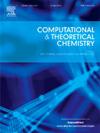Improving the electronic and optical properties of silicene by doping with transition metals – A DFT investigation
IF 3
3区 化学
Q3 CHEMISTRY, PHYSICAL
引用次数: 0
Abstract
The density functional method is used to study the structural, electronic, and optical properties of pristine silicene and, also the modification happened in these properties due to the substitutional and additional doping of transition metals atoms, which include Au, Ag, Co, Cu, Fe, Ni, Pd, Pt and Zn. Firstly we constructed the structure by replacing one silicon atom with a metal atom using the substitutionally doped method. We also studied by adding the metal atom in the hollow region of the silicene sheet using the additional doped method. An analysis of the structural characteristics and stability of the designed structures has been performed by calculating the formation energy. The electronic properties of both pristine and doped silicene systems, including the HOMO-LUMO gap, the density of states, dipole moment, Mulliken, and NBO charge distribution, as well as quantum chemical parameters and optical properties such as the maximum absorption wavelength, excitation energy, and oscillator strength, have been thoroughly examined and analyzed. In conclusion, doping metals by both methods changed the characteristics of silicene and it is anticipated that the doping of silicene with transition metals will provide renewed opportunities for adjusting and strengthening silicene's electrical and optical properties.

求助全文
约1分钟内获得全文
求助全文
来源期刊

Computational and Theoretical Chemistry
CHEMISTRY, PHYSICAL-
CiteScore
4.20
自引率
10.70%
发文量
331
审稿时长
31 days
期刊介绍:
Computational and Theoretical Chemistry publishes high quality, original reports of significance in computational and theoretical chemistry including those that deal with problems of structure, properties, energetics, weak interactions, reaction mechanisms, catalysis, and reaction rates involving atoms, molecules, clusters, surfaces, and bulk matter.
 求助内容:
求助内容: 应助结果提醒方式:
应助结果提醒方式:


